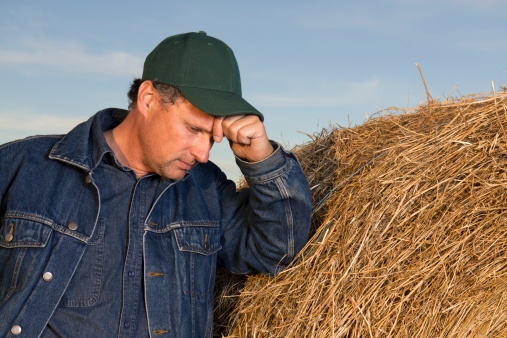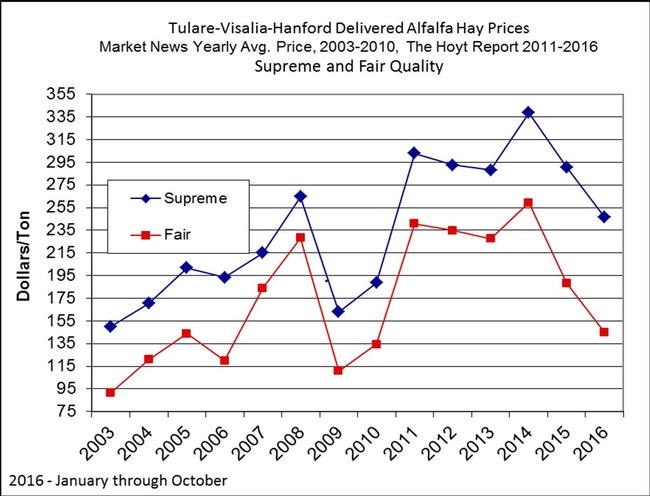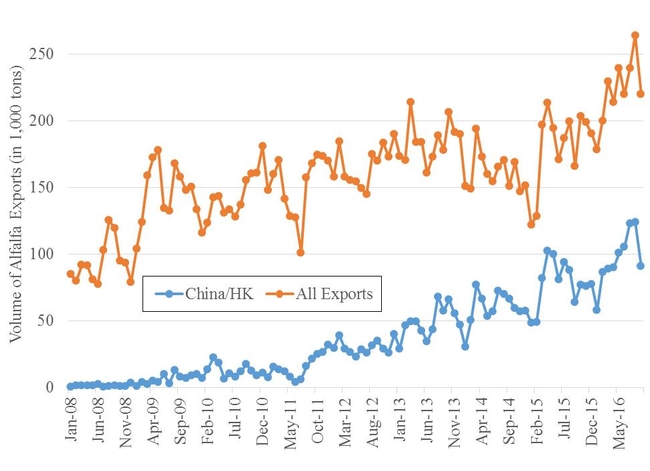Alfalfa hay prices were quite painful for alfalfa producers in 2015-16 as low commodity prices and lack of profitability in the dairy sector drove hay prices to the lowest level in many years. While high quality hays still fetched good prices, price for lower quality hays often were $80-$100/ton lower than high quality alfalfa due to high supplies and lack of demand.
This was a year that a lot of hay producers would like to forget.
(Google image)
The hay industry in California was worth between $1.5 billion and nearly $1.8 billion dollars in 2011-2015 (farm value), including both alfalfa and grass hays (USDA-NASS data), but is likely to be lower than this in 2016 due to low prices and acreage.
Exploration of California Hay Market Issues Now Available on-Line
The economics of the hay industry, dairying, effects of world trade and exports was the subject of a session at the recent California Alfalfa & Forage Symposium held in Reno, Nevada, Nov 29-Dec. 1, 2016. This program, now in its 45th season, is organized annually by the University of California Cooperative Extension, and sponsored by the industry group California Alfalfa & Forage Association (CAFA). This year featured 575 attendees and 83 exhibitors. Full videos, PowerPoints, and Proceedings is available on-line at http://alfalfa.ucdavis.edu
Venerable Hay Market Analyst Seth Hoyt (The Hoyt Report), kicked off the session with his annual knowledgeable review of the state of the industry (sponsored by CAFA). Seth described the decline in CA alfalfa acreage and alfalfa fed per day in dairy rations, and concluded (with plentiful “ifs”), that if milk prices improve and exports continue to grow, prices alfalfa could prove to be stronger in 2017, but the dry cow market may take longer to recover (see Powerpoints and Proceedings: http://alfalfa.ucdavis.edu/+symposium/2016/powerpoints/1_Hoyt_HayMarket.pdf).
Figure 1. Changes in hay price for California's Central Valley location. Hay prices took a nose dive in 2015-16, similar to the trend in 2009-10 (See Seth Hoyt's presentation).
California Dairy's Manager Dr. Eric Erba described the volatility of the California dairy industry, from high-to-low profitability from year to year, but suggested that in the past 2 years, the balance of the CA industry has fundamentally changed. While for decades, the industry struggled to balance supplies with processing, in 2015-16 finding enough milk to keep processing assets running was the major issue. Eric described the changes that have taken place in the CA dairy shed, for example, diversification into permanent crops (orchards, vineyards), and increased intensity of environmental restrictions (see Video and Powerpoints): https://lecture.ucanr.edu/Mediasite/Play/02ece95b7e3c48d397f0ef4815fdddd41d
UC Davis Economist Dr. Daniel Sumner followed by describing the uncertainties of the market in his talk “When someone tells you they know Where Commodity Prices are Really Heading, Grab your Wallet and Run”. He pointed out that pundits are not very good at prediction, nor are commodity futures traders, who have real money at stake. Agricultural commodities and trends are famously difficult to forecast, since there are so many factors involved, which he described in some detail. Seed video at https://lecture.ucanr.edu/Mediasite/Play/409a4823c4374ebf81d8b02c6fcd15601d and proceedings and PowerPoint at: http://alfalfa.ucdavis.edu/+symposium/2016/index.aspx
Dr. Dan Putnam, UC Forage Agronomist (yours truly) described the changes in export markets, particularly the phenomenal increases in alfalfa exports to China, now nearly 1.5 million Metric tons/year. The year 2016 promises to be a record year for exports, with 4.7 million MT exported. Japan, China, other Asian countries as well as Middle Eastern Markets are the primary destination ports. The sensitivity of export markets to GMO crops (Genetically Engineered crops) and the need for production of non-GE crops for export and organic production was covered, as well as research data on measurement of low level presence of GE traits in hay. A video of this presentation is at: https://lecture.ucanr.edu/Mediasite/Play/4d96e80dc8a64690a5deed82959dc1641d and the PowerPoint and 2 papers are at; http://alfalfa.ucdavis.edu/+symposium/2016/index.aspx
Figure 2. Alfalfa Hay Exports have increased dramatically in recent years, especially to China and Asia (see Putnam talk). Exports to China alone may be 1.5 million Metric tons in 2016, up from near zero 10 years ago.
So Prices are Down - What to Do?
Perhaps the most important talk was given by Steve Orloff, UC Farm Advisor, who talked about ‘Reducing Costs in a Down Year – Where to Cut an Where not to Cut”. After all, other than curling up into a ball, growers need to find responses to low prices to survive a down year. Steve points out that cutting costs in some areas (like reducing weed management or choosing cheap seed) may not be the best strategy, since yields and quality will be greatly affected. However, he described other opportunities for cuts in inputs, which may be important to the bottom line. Video is at: https://lecture.ucanr.edu/Mediasite/Play/6936afd9ae5d46d5b5bc3bbb571230051d
The full links to the symposium is at: http://alfalfa.ucdavis.edu/+symposium/2016/index.aspx
Conclusions
This review of the alfalfa industry by experts describes the complexity of predicting how markets may change in the near or far future. Since domestic dairies are the primary market for alfalfa, their economic health is of primary concern, but the factors at play are much more than this. These factors include 1) Price of milk, 2) Rate inclusion of alfalfa in dairy rations and competition from other feedstuffs such as corn silage and almond hulls, 3) Relative price of other commodities including corn grain, 4) Acreage of alfalfa and yield variation each year, 5) Export demand for hay and milk and international forces, such as currency value and price, 6) Relative demand by horse and other domestic markets, 7) Political and policy decisions by governments. These are highly interactive, and many of these factors work in opposition to others which influence price.
Given the record low acreage of alfalfa in CA (down to 820,000-860,000 acres in the past few years, from 1.1 million acres 8 years ago), the steady march of permanent crops in the state (almonds alone are now 1.1 million acres), and the restrictions due to water & drought, many do not expect alfalfa acreage to expand back to their highest historical level. Since demand still remains high for dairy and export, this should be enable remaining growers to take advantage, but that is obviously too simplistic, as we've seen. The low dairy price proved to be an overwhelming factor this year, but dairies were still willing to purchase high quality hays. The importance of quality during these down years (averaging $100/ton gained or lost) should be a strong signal that growers shouldn't just produce ‘stuff that cows eat' but pay attention to quality as well as yield, especially in a down year.
Oh, and to answer the question in the title as to whether prices will go up or down in 2017 the answer from this group of experts, as we can see, is......
…………………………wait for it
………………………………..a little longer
……………………………………………………YES!!


